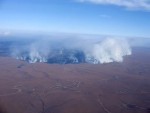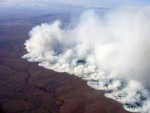The tundra of the Arctic LTER site, Alaska, sits above hundreds of meters of frozen ground (permafrost). Because of this drainage barrier and low evapotranspiration during the cool, often cloudy summers, the scant summer rainfall keeps the tundra moist. However, in the exceptionally dry summer of 2007 a fire sparked by lightning on July 16 burned 256,000 acres, and continued until the end of September when nearby lakes had already frozen over. This was the largest fire in Alaska in 2007 and by far the largest ever recorded north of the Brooks Range. In the 33 years of research at the site, we recorded only two brief fires covering a few dozen acres.
Unlike the gigantic fires in interior Alaska, tundra fires are driven more by unusual climate conditions than fuel availability. Characteristically, flames creep along burning the low-lying vegetation and peaty soils; there is no tall tree canopy and no firebrands, so natural barriers like streams and rivers easily stop fires.
The Arctic LTER project site is only 23 miles to the southeast of the fire location. There being no roads, the only way to reach this site is by ski plane in the winter and helicopter in the summer. Despite logistical difficulties, the LTER project has decided to describe and analyze the aftermath of this fire because it represents an opportunity to study the effects of a major arctic disturbance at the landscape and whole-catchment scale. The burned area includes multiple first through third order catchments, both with and without lakes, and about half the area is rolling foothills and the other half flat plains. Gus Shaver, of the Marine Biological Laboratory, is leading the fire project.
The obvious changes will be to the vegetation. Our observations suggest that if the fire stays on the surface and does not destroy all the organic matter in the upper layers, then some plants will resprout this spring, that is, in late May. A more intense fire will burn away the peat and organic-rich soils and the tundra will take centuries to revegetate. In addition to changes in the plants and soils, there will be large fire-caused differences in the exchange of energy and CO2 with the atmosphere, and probable changes in the nutrient balance of streams and lakes. The change in the energy balance, caused by changes in surface albedo and insulation by the plant and organic layers, will hasten thawing of the ice inclusions in the permafrost, slumping of soil on hillslopes, and movement of sediments and nutrients into streams and lakes.
The LTER project has obtained Small Grants for Exploratory Research (SGER) funding from the National Science Foundation's Office of Polar Programs for logistics costs and for initial sampling of the fire's impacts. Additional SGER funding will come from the NEON program to test NEON protocols, instrumentation, and remote power setups with a series of flux towers measuring carbon, water, and surface energy balance. Not only will this new project allow a long-term investigation of recovery but will also take advantage of a natural experiment at a very large scale.

 Enlarge this image
Enlarge this image
